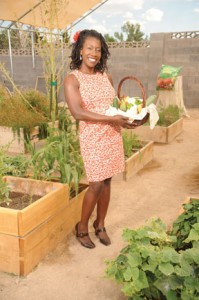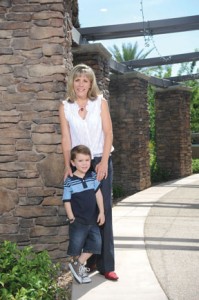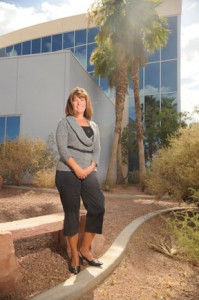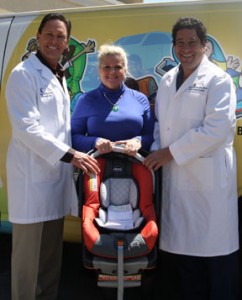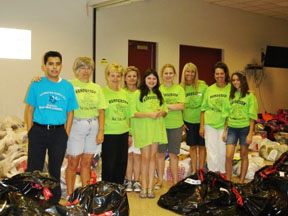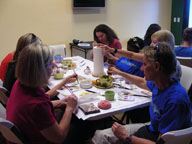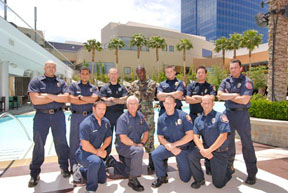Pounds vs. Progress – Breaking Free from Scale Tyranny
By Michelle Vessel
You’re locked in an intense battle of the bulge. For the last few days, you’ve been a model dieter, keeping portion sizes in check, steering clear of junk foods, sweets and extra snacks. You’ve hit the gym every day, too, working out hard and pushing yourself to the limit. Now you’re ready to find out whether your efforts have paid off. You excitedly clamber up on the bathroom scale, but to your chagrin, the display indicates that you’ve somehow managed to gain four pounds. Dissolving into frustration, you drown your sorrows in a pint of mocha nut fudge ice cream. Nothing you do seems to matter anyway, so why even bother reining it in, right?
This kind of setback is all too familiar for millions of people fighting the good fight to lose weight. We’ve been conditioned to believe that a shrinking number on the scale is the ultimate validation of our weight loss efforts, and when the scale doesn’t reflect the kind of positive results we’re looking for, the effects can be devastating. Indeed, it’s likely that many a New Year’s resolution or newly minted fitness regimen has been torpedoed by a scale that stubbornly refuses to budge. It doesn’t have to be this way.
An Unreliable Benchmark
Let’s step back and consider the big picture. What are we really trying to accomplish when we say we’re trying to lose weight? In most cases, we’re actually trying to shed excess fat, and if our goal is to look better in our clothes and feel more confident in our own skin, gaining muscle tone should be part of the program, too. Unfortunately, most of us mistakenly believe the scale is the best way to gauge our success or failure. The problem is that scales only provide a one-dimensional snapshot of our total weight in pounds that includes everything: fat, muscle, bones, skin, hair, clothes, shoes, even the half-gallon of iced tea you downed over the course of the day.
What dieters should keep in mind is that human body weight is a constantly moving target. Even when you’re not actively trying to shed pounds, it’s not unusual for your weight to fluctuate up and down between five to seven pounds within a 24-hour period. Here are just a few of the factors that can cause your “scale weight” to change.
- Water weight. If you’re consuming anywhere close to the 100 or so ounces of water that most health experts say we should drink each day, that’s the equivalent of nearly seven pounds of weight that could be skewing the number on your bathroom scale, according to researcher Michael Boschmann, M.D., who has studied the weight-loss effects of hydration.
- Hormonal shifts. These chemical compounds regulate the function of organs and systems in the body, but they can also prompt shifts in weight and water retention, especially in women. In fact, according to Robert Berkowitz, M.D., medical director of the University of Pennsylvania Weight and Eating Disorders Program, many women experience an uptick of three to five pounds the week before menstruation due to hormonally induced bloating and water retention.
- Muscle and fat. When you’re engaging in regular exercise, it’s likely that you are increasing your muscle mass and losing fat at the same time. To a typical bathroom scale, however, there’s no difference between the two, so a gain of five pounds of muscle and a loss of five pounds of fat will show up as no change on the scale, which many frustrated dieters see as a sign that they’ve made no progress whatsoever.
The bottom line is if you’re making an honest effort to slim down and shape up, your scale probably isn’t the best way to gauge your progress. In fact, it could be hindering your ability to develop a healthier relationship to your body.
Better Benchmarks
So if the typical bathroom scale isn’t the best way to chart your journey to a trimmer physique and better health, how will you be able to tell if you’re stuck, moving forward or losing ground? There are dozens of accurate and motivating methods out there; choose one that resonates with you or develop your own unique approach using a combination of these basic techniques.
Track Your Measurements
Virtually every fitness expert worth his or her salt swears by the tape measure rather than the bathroom scale as the most accurate measure of weight loss progress. Many dieters who think their weight loss efforts are stalled may be shocked to find out that they’re dropping inches like crazy, even when the scale hasn’t budged for weeks or even months at a time. All you need to use this method is a basic tape measure and a notebook or spreadsheet. Most weight-loss gurus recommend checking your stats once a week at the widest point of the neck, upper arm, bust, waist, hips and thighs.
Highlight Healthy Habits, Not the Outcome
Experts say that when it comes to slimming down, the process of establishing healthy habits is often more than half the battle. If you’re just starting out or are stuck because you’re fed up with a seeming lack of progress, try taking the focus off your results for a while and concentrate on cultivating healthy habits. Track your food intake and daily exercise regimen, but hold off on weighing yourself or otherwise charting your progress for a few weeks. If you’re really intent on creating long-term, lifestyle habits that you’ll stick to no matter what your circumstances happen to be at any given time, it’s probably best to dissociate your efforts from a short-term goal like dropping a few pounds.
Use Clothing Sizes to Track Your Progress
Within just a few weeks of eating healthier food and exercising more often, you’ll probably start to notice that your clothes are fitting you better. Some dieters take this a step further by using a pair of “dream jeans” or a favorite dress or outfit to try on once a week or so as a way of keeping track of weight loss progress. Visiting your favorite boutique to see if you can squeeze into the next smaller size can be a great motivational tool. Be sure you’re using a garment that you actually have a chance of fitting into eventually as your benchmark; trying to squeeze into a pair of skinny jeans from the junior’s department may do more harm than good.
Set Externally Focused Goals
Another way to overcome your dependence on the scale is to frame your health journey around a specific fitness goal like running in a 5K race, completing a challenging hike or finishing a killer workout class at your gym without collapsing into a puddle of tears, then set up a rigorous training plan that will get you there. Better yet, consider competing in an athletic event that benefits charity. When you turn your energy outwards and focus on helping others, the frustration you’ve faced in your struggle to slim down will start to fade into the background–where it belongs.
Weight loss doesn’t have to be a mind-numbing numbers game. Remember that most scales aren’t sophisticated enough to measure the real progress you’re making with all of your hard work and willpower. Instead of letting the number on the scale tell you how you should feel about yourself, define and celebrate success on your own terms, according to metrics and milestones that make sense to you.
Tips for Treating – A Proper Prize for Pooch
By Ashlee Verba
You know they know where you keep them, what sound the wrapping makes and what exact trick will seal the deal in earning that glorious prize. When it comes to incentives, nothing does it quite like a good treat. But what makes a good treat good? As owners, we buy what we think our pets enjoy most, be it the taste of bacon or the chewiness of those sweet potato morsels. But what we rarely consider is what goes into those treats that go into your dog and how it might affect his overall health.
Regulation
Dog treats are federally regulated under the Federal Food, Drug and Cosmetic Act (FFDCA) established by the Food and Drug Administration. Yet, even with regulations in place, there’s still some question as to the nutritional value of animal treats. Think hot dogs or frozen fish sticks; the FDA may approve them as “edible”, but the impossibly long list of ingredients might make you suspect otherwise. A mish mash of pieces and parts, additives, preservatives, artificial flavors and other chemicals make them some of the most unhealthy food on the market. The same may hold true for your go-to pet treat.
A Winning Strategy
Finding the best treat for Fido is all about reading labels. Similar to human food, ingredients are listed in order of weight, meaning the first few make up the bulk of it. Because dogs are primarily carnivores, ideally you want a treat that has meat listed as one of the first ingredients, followed shortly by vegetables, fruits and natural preservatives like rosemary. A good rule of thumb to follow is that the easier and more recognizable the ingredients the better.
Things to avoid include artificial colors or flavors, high levels of sodium, sugar, saturated or trans-fats, propyl gallate (a potentially cancer causing preservative) and byproducts. Byproducts, whether meat or grain, are simply cheap fillers used to make more product with less money. While meat byproducts contribute a small amount of protein, they typically consist of parts not favorable for human consumption, i.e. necks, heads, feet, intestines, kidneys, brain, spleens, bone meal and “digest of beef or chicken”, which refers to undecomposed flesh. Since dogs in the wild would generally eat these parts of the animal anyway, albeit in more natural proportions, the inherent problem with byproduct is not simply what it is but where it comes from. There is no quality control or regulation on where these meat parts are obtained. At worst, they could have come from animals that were deemed inedible and rejected by butchers. If you could get sick from it, do you really want your pooch eating it?
In some cases the word “byproduct” will be on the ingredient list, as in “lamb byproduct”, but they aren’t always so obviously named. “Potato product” and “grain fermentation soluble” are grain byproducts that should also be avoided. Treats containing byproducts can be up to 70% carbohydrates–the dietary recommendation for dogs is only 30%. Too many carbs in Fido’s diet could lead to digestive issues as well as all the long-term effects of obesity.
Tip: Avoid the carb/additive/preservative overload by selecting a treat labeled “Certified Organic” by such makers as Wet Noses, Karma and Plato.
Lactose and other dairy products should also be avoided in both store-bought and homemade treats. Most canines don’t have enough of the enzyme lactase in their system to break it down, which can cause gas, diarrhea and even inflammation of the pancreas. High sugar levels should be avoided as well, as sugar creates an excellent environment for the over-growth of bad bacteria in the mouth and stomach, which can lead to digestive issues and discomfort.
Long-Term Chew Treats
So what about rawhide bones and pig ears? The ingredient is pretty straightforward, but there are still particulars to look for on the label. Both are typically treated with chemicals when being processed; however, U.S. produced rawhide and pig ears are held to sanitation and production standards, whereas those produced in other countries may have been treated with toxic or illegal chemicals. To ensure your mutt isn’t biting off more than he bargained for, make sure you purchase chews that have been manufactured in the United States. Don’t be fooled by pictures of American flags on the packaging or ambiguous statements like “Made from U.S. beef” either; it must specifically say “Made in U.S.A.”
Rawhide chews and pig ears have pros and cons. Nutritionally speaking, rawhide is high in protein, around 80-85%, contains 10-12% fiber/moisture and 1-2% fat, making it lower in fat than pig ears. It also contains fewer calories per ounce than the typical dog biscuit. This particular type of treat should only be chewed for a few hours per day. Pig ears, on the other hand, contain little nutritional value and are very high in fat. For this reason, they should be considered a special occasion treat only.
Each lets your dog indulge his natural desire to chew while strengthening his jaws, scraping plaque and alleviating teething pain in puppies. They can also act as a mental stimulant for older, less active dogs. For voracious chewers, problems may arise when large chunks of rawhide are consumed. Enzymes in the stomach can cause a piece to soften and enlarge, which could result in a digestive blockage requiring surgery to fix. Both pig ears and rawhides also have the potential to splinter or break off in small, jagged pieces that can perforate the intestines.
If your dog is an aggressive chewer/swallower, monitor his chew time closely; if he tends to break off large pieces and swallow them or you notice the treat is splintering, toss it and find an alternative. All-natural bully sticks are a good option to stave off boredom, but should only be given for 2 hours per day for their poor nutritional values. If your dog insists on devouring chews rather than chewing them up slowly, try sticking with treats that are meant for instant consumption.
Natural and Homemade Treats
Of course there is always the option of obtaining treats on your own terms. If you want to give a dog a bone, remember that pork, chicken and other poultry bones are not an option. They are far too thin, splinter easily and can also get lodged in the throat or roof of the mouth. Beef bones are best, specifically knuckles, and your local butcher just might have one for you. Just be sure to select a size appropriate to your breed. You don’t want to give a Great Dane a golf ball sized bone he can easily swallow. Make sure it has neither been cooked nor frozen at any point, as that increases the chance for splintering. No matter the type of bone, there’s always a choking risk. Always monitor your dog’s consumption.
To bypass mass producing companies altogether and support local commerce, try visiting treat bakeries like Barking Dogs Bakery & Boutique, Three Dog Bakery and Alaska Bakery. These businesses offer fresh-baked treats for pets made from natural ingredients and a lot of love. Pet treateries are increasing in popularity and can be found all over Las Vegas; Google the one nearest you.
Great dogs deserve great treats. Make sure they’re getting what they deserve, even if that just means making the small step to consciously read the label.
A Tasty Treat Fit for Humans
Nothing says lovin’ like homemade goodies from the oven. Spoil your pooch with this easy, home baked treat.
Ingredients:
- ¼ cup chicken broth
- ⅓ cup cottage cheese (fat content is up to you)
- ⅓ cup mashed black beans
- ½ lb uncooked ground beef
- 1 teaspoon soy sauce
Preheat oven to 375°F.
Mash together ground meat, soy sauce and chicken broth in a mixing bowl. Add cottage cheese and mashed black beans to the mixture. Combine all the ingredients and mold small cookies into bone shape. Grease a cookie sheet and place treats in even rows. Bake for 45 minutes. Cool and serve.
Dr. Lisa Marie Lyons
By Callie Thomas
“There is nothing certain in a man’s life but that he must lose it.” – Owen Meredith
Throughout our lives we strive for understanding and respect. When we are faced with meeting the end of it, we seek the same. Resident Dr. Lisa Marie Lyons works every day with patients and their families to provide guidance and quality end-of-life care.
Lyons earned her degree in Clinical Laboratory Medicine from the University of Nevada School of Medicine. She eventually worked in the laboratory at UMC and the VA in Reno and went back to school to become a physician. “I decided to pursue becoming a physician because I very much enjoyed the contact with patients, particularly at the VA,” says Lyons. “I attended the University of Nevada Reno School of Medicine and had my residency at UMC in Internal Medicine.” She is proud of her accomplishments in becoming a doctor, particularly having finished medical school as a single parent of son Cameron. Today, she is Senior Director of Medical Affairs at Nathan Adelson Hospice, the largest nonprofit hospice in Nevada and one of the first founded in the nation. “It is a privilege to work at a hospice that is known as a trusted partner in the community and has provided care for patients and their loved ones for more than 30 years,” she said.
Nathan Adelson was a beloved hospital administrator who was known to care deeply for both his patients and employees. After enduring a long and painful battle with stomach cancer, Mr. Adelson passed away, but friends and family members realized the need for healthcare specific to pain management and responded to that need. Nathan Adelson Hospice became the first home care hospice to provide patients and loved ones with comprehensive end-of-life care and has influenced better care throughout the community. The facility honors the choices made by those who are ill and provides patients with both comfort and dignified care. “I love my job and believe that hospice care truly brings comfort to the patient and families. I have a wonderful family and a great team I work with at Nathan Adelson Hospice. The team mentality allows individuals to be successful while improving the care of our community,” she said.
Outside of her duties as Senior Director of Medical Affairs, Dr. Lyons is involved with fundraising efforts which are hosted annually by the hospice, including its signature Flair for Care Fashion Show and Luncheon, which featured spectacular designer looks and raised $600,000 this past April. She also supports the annual Wine Tasting Extravaganza, which will be held this October 14th. This event includes wine and food sampling from some of the best restaurants in the city, with an auction and live entertainment adding to the festivities. “The fundraising activities at Nathan Adelson Hospice help bring home the point to the community that we are here for them, support them and will always be their partner.”
Dr. Lyons also makes time to reach out in other ways. She is the current president of the University of Nevada School of Medicine Alumni Association and a past council member of the University of Nevada Reno. “We provide scholarships to medical students, funding for missionary trips and reconnect school alumnus.” She is also passionate about our four-legged neighbors and is a member of the ASPCA and donates to the Southern Nevada Pug Rescue and Lied Animal Foundation. Lyons also donates her time to her church, Central Christian, and is working on becoming a gallon blood donor.
On her down time, Dr. Lyons can be found tending to her organic garden with husband Jeffrey Maloney as well as enjoying her son, four stepchildren and four grandchildren. She is committed to continuing to helping others throughout the community. “It is very important to serve the community that serves you. I see service as a part of everyday life.”
Jennifer Morss
By Callie Thomas
“Well-behaved women seldom make history.” – Laurel Thatcher Ulrich
The work of Pulitzer Prize-winning historian Laurel Thatcher Ulrich, which centers on the history of women, has been described as a tribute to the silent work of ordinary people. Resident Jennifer Morss not only relates to the author’s observation, but is an active proponent of conveying the idea that anyone can make a difference.
In 1999, a television special on HIV/AIDS was the influencing factor that motivated Morss to get involved. “I learned of individuals with HIV, dying alone in hospital beds without any friends and family around them,” she said. “At that moment, I decided to become involved and affect change in the treatment of HIV positive individuals by working to decrease HIV related stigma and discrimination.” She completed HIV educators training through the American Red Cross and volunteered as an HIV Prevention Educator in detention and drug recovery facilities.
“While I loved working as a volunteer, I still had not met anyone who was HIV positive, nor was there the feeling that the work was ultimately diminishing the existing stigma for these individuals,” says Morss, who eventually moved to Las Vegas in 2001 and began working at AFAN (Aid for AIDS of Nevada) as the Project UpFront coordinator. Since that time, she has held a range of positions including Director of Programs, Director of Operations and Associate Director. Morss currently holds the position of Executive Director for AFAN. She has described her work as “life changing.”
AFAN advocates for both adults and children living with and affected by HIV/AIDS in Southern Nevada. The group works to reduce HIV infection through prevention education to eliminate fear, prejudice and the stigma associated with the disease. Project UpFront incorporates a group of HIV positive speakers that communicate prevention messages throughout the community. The program targets students and community agencies working with high risk youth and young adults. The interactive program features a panel of presentations where HIV positive individuals tell their personal stories about living with HIV/AIDS and answers questions about their lives and past risk behaviors. “The amazing, talented and courageous individuals of the Project UpFront program taught me many things about appreciating life and taking time to enjoy the journey–life lessons that impact me to this day.”
Perhaps one of the most important AFAN events in which Jennifer has been involved is the annual AIDS Walk Las Vegas. She has been involved with the planning and execution of the event for the past nine years. Morss has witnessed the event’s growth from less than 1,000 walkers to more than 8,500 walkers. The event raised more than $500,000 last April. “I am forever humbled by the overwhelming support we’ve received for this event, and I’ve enjoyed planning every single walk.”
In addition to her duties as Executive Director of AFAN, Jennifer has also served as the Vice President of the Southern Nevada Coalition of HIV/AIDS Service Providers for the last six years. “I’m passionate about advocacy,” she said. “I chose to participate with the organization because of their strong advocacy efforts for people surviving with HIV/AIDS.”
Jennifer Morss is honored to do what she can for the HIV community of Southern Nevada. She aspires to see the day when a cure and a vaccine for HIV are realized and when she will never lose another friend to the HIV disease. She is also looking forward to graduating from the Master’s of Health Communications Program from Boston University. All the while, in whatever capacity Morss is working, she motivates others to lend a helping hand. “When people ask me ‘how do I make a difference?’ my answer is GET INVOLVED. Whatever your passion is, find a way to get involved, because together we make a difference.”
Kristy & Jack Littauer
By Callie Thomas
It has been said that you are what you eat, and particularly for those afflicted with extreme food allergies, what you eat can be a life or death proposition. According to the Food Allergy & Anaphylaxis Network, more than 12 million Americans have food allergies, and experts say the numbers are rising. The incident is highest among young children—about three million children in the U.S. have food allergies. Even a mere trace of a food allergen can cause a reaction, and most are due to something they thought was safe.
Resident Kristy Littauer and her four year old son Jack are all too familiar with food allergies. It is something Kristy, her husband Fred and their daughter Lianna have become knowledgeable about after discovering Jack’s food allergies. “Jack was just an infant when we found out he has severe food allergies,” says Kristy. “After going through the normal ‘green’ baby food, I decided to add some variety and give him creamed spinach. He took a few bites and started wheezing and his neck and chest broke into hives. I called 911 and he was rushed to the emergency room and treated for food induced anaphylaxis.”
That was the first of three other near-fatal episodes that young Jack has endured. Although the family has become hyper-vigilant about the foods that are given to him to eat, dining in a restaurant proved another terrifying experience. “When we were out to dinner with friends, I brought food from home for Jack,” Littauer said. “But the other kids were getting ice cream for dessert and he wanted a treat too. I saw that there was sorbet on the menu so I asked the server if she could check to see if the sorbet had dairy in it. I made it very clear that my son is deathly allergic to dairy.” Needless to say, while the server had checked with the kitchen to ensure that it did not, the child only had a few bites of it before he stopped breathing and was rushed to the hospital, landing in ICU. “We found out after the ordeal that the restaurant was out of sorbet so she served him sherbet which is made with milk.”
Kristy has devoted herself to helping her child, as well as others with food allergies by joining the Food Allergy & Anaphylaxis Network (FAAN). A nonprofit organization, FAAN’s mission is to raise public awareness, provide advocacy and education, and to advance research for those suffering from food allergies. “FAAN gave me resources and knowledge to feel empowered over Jack’s condition,” Kristy said. She is also an active member of Food Allergy Parent Education, a local parent support group. “Along with other volunteers, we organized the first annual fundraising walk. More than 600 walkers attended, and the event raised over $40,000. This year’s event will be held on September 25 at the District.” She is also grateful to the National Jewish Medical Center in Denver where they were able to get additional information about Jack’s allergies. The family helped the center create a video on food allergies which was used in a recent fundraising event with proceeds going to research.
Kristy Littauer is determined to continue giving her time, knowledge and understanding to help others improve their lives. “If our experiences and knowledge can save one life, make one family’s life easier or raise money to find a cure for this condition, I will work tirelessly to do it.” For more information on FAAN, visit www.foodallergy.org. To join in on the September walk, visit www.foodallergywalk.org/lasvegas_NV10.
Patty Charlton
By Callie Thomas
Every success begins with a good foundation. Which is why every student that aspires to reach their educational goals, can be thankful for the efforts of 89012 resident Patty Charlton. Patty is in the business of providing students with the educational opportunities to be successful. She puts her financial wizardry into motion to help bring about the necessary programs, resources and inspirational teachers and mentors that guide our students and provide the quality education that breeds future success.
Patty Charlton discovered her knack for the financial side of business as a student herself, having attended the College of Southern Nevada (formerly known as Clark County Community College) where she received an Associate’s degree in Business Management. She later attended UNLV and received a Bachelor’s degree in Management Information Systems and eventually a Master’s in Public Administration. “During my college years, I worked in the banking industry and found that I had a real interest in finance and associated fields,” says Charlton. “I began working at the college and during that time have worked in the finance area in a variety of positions.” Those positions included working her way up from Administrative Assistant and Budget Director to her current position as the college’s Senior Vice President for Finance & Facilities.
Charlton has gained valuable experiences through her work, which has provided her with the opportunity to interact with the faculty, staff, students, community, legislators and the CSN Foundation. “I have been able to see firsthand the wonderful programs we teach, student demand for education and the outcome of our teachers and motivators that inspire our students on a daily basis,” she said.
As an administrator, Patty has an ongoing involvement with the CSN Foundation, which is comprised of business and community leaders and supports student programs at the college, as well as secures donations, equipment to build classrooms, laboratories, auditoriums and academic buildings. The foundation recently funded over $1 million dollars for new scholarships and programs at CSN.
Charlton also lends her skills in organizing and assisting the group’s special events such as the Great Steak Out, an evening of select delicacies and wines to raise funds for students in the hospitality program, as well as the Annual Golf Tournament which will be held this November. Participants have an opportunity to play with celebrity baseball greats such as Greg Maddux, Aaron Rowand, Mike Dunn and Steve Garvey to raise funds for the foundation. “Through the annual CSN Golf Tournament we have been able to actively participate in support of Inter-Collegiate Athletics at CSN,” says Charlton. “The college receives no public support for this program, and operations are dependent on private and other resources.” As a result, the college has a men’s baseball program and women’s softball team where student athletes have historically been from local high schools who have shown academic excellence in the classroom and on the field.
One of the foundation’s programs that Charlton is particularly proud of is the introduction of the Justin Bailey Scholarship. “Justin was a veteran and son of one of the CSN family who passed away at a young age. We established a scholarship in his name that was generated through donations that benefit veterans who are returning to school.”
Patty Charlton is the proud mother of daughter Taylor, and when she isn’t influencing the future of others, she is excited about her new hobby—learning to golf. Charlton also looks forward to furthering her own education by pursuing a Ph.D. at UNLV. As a former and future student, she identifies and rejoices in the successes of the CSN students. “I look forward every year to the graduation ceremony where hundreds and hundreds of students walk across the stage, accept their diploma and sharing in the experience of their great accomplishment.”
Desert Perinatal Associates
Drs. Joey Adashek and Paul Wilkes of Desert Perinatal Associates spend their days caring for and dispensing invaluable advice to women with child. Wanting to give equal attention to certain precautions once the baby is born, they’ve recently partnered up with Safe Kids Clark County, a nonprofit organization dedicated to the prevention of injury to children.
In the U.S., car crashes are the leading cause of death for kids under the age of 14. Research shows that the use of a properly installed car seat can reduce the risk of death by 71% for infants and 54% for children ages 1 to 4. Additional research shows that although 96% of parents believe they install and use their car seats correctly, nearly 73% of car seats are misused.
Starting in mid-April, the good doctors began sending “car seat prescriptions” home with new parents to spring load their campaign for child safety. With the help of Safe Kids Clark County, they’ll also be conducting car seat checks at Belly Bliss/Desert Perinatal Associates (5761 S. Fort Apache Rd.) on the 4th Saturday of each month from 9 a.m.-noon. The cost is $20, but you just can’t really put a price on the knowledge that your child is safe, can you? For more information, visit www.desertperinatalassociates.com or www.safekidsclarkcounty.org.
HopeLink 9th Annual Henderson Back 2 School Celebration
Soon enough, children across the valley will be getting saved by the bell. But before the school year commences, there’s work to be done for children who don’t have access to new supplies for the new year. HopeLink, a Henderson nonprofit organization, is teaming up with other like-minded organizations and community members to help provide much needed “back to school” essentials to children from low-income families.
“More families than ever are struggling to get school supplies and clothing for their children,” said Daniele Dreitzer, executive director of HopeLink. “Together, we can help these deserving kids start the school year right with necessitites like school supplies and a new outfit for the first day of school.”
The 9th Annual Henderson Back 2 School Celebration will be held on August 21st at the Valley View Recreation Center, during which backpacks filled with school supplies and a new outfit will be presented to approximately 1000 children. While Central Christian Church supplies all the backpacks and school supplies, HopeLink matches area businesses, faith communities and individual donors with one or more children. Donors ‘adopt’ a child and shop for complete outfits so that every child has at least one new outfit to start the school year with a smile. For more info, visit HopeLink’s website at www.link2hope.org.
Color Me Mine
Ah the dog days of summer; staying cool by the pool, warm sun and family fun. But what of those moms and their children who don’t have swimsuits let alone a waterin’ hole to play in? Well, Color Me Mine paint-your-own pottery studio in The District came up with a colorful solution.
Carla and James Arriola, owners of Color Me Mine, wanted to give back to the community. Their canvas of choice? Safe Nest, providing shelter, counseling, advocacy and prevention services to abused women and children. On June 24th, Carla and James donated their studio for the first ever event of its kind. In lieu of paying the studio’s normal painting fee, guests donated swimsuits to Safe Nest. In return, they painted for several hours while noshing on appetizers and wine samples donated by Renato Lebron from Trader Joes on Eastern.
After all was donated and painted, Safe Nest received 40 swimsuits. Later that week, some grateful Safe Nest families spent a much-needed afternoon laughing, splashing and enjoying being together at a private donor’s pool. For more information on Safe Nest, visit www.safenest.org. For info on Color Me Mine, call 522-1338.
Fire & Rain Firefighter Bachelor Auction
Firefighters might be best known for putting out flames, but on Saturday, June 19th the tides turned as they heated up Rain Nightclub inside the Palms Casino Resort. Eighteen of Southern Nevada’s bravest firefighters upped the temp to smokin’ hot degrees when they took the stage for the 11th Annual Fire & Rain Firefighter Bachelor Auction.
Of course, there’s little to complain about sweltering indoor heat when it’s for a good cause, and as a fundraiser for The Firefighters of Southern Nevada Burn Foundation, that it was. A non-profit organization, the Burn Foundation’s mission is to provide assistance to burn victims and their families, assist in catastrophic events as a resource to the community and to further educate the community of fire and life safety.
“A lot of hard work went into making this event a big success,” said Warren Whitney, public information officer for the Burn Foundation. “We received a tremendous amount of support from our community partners, bachelors, volunteers and those who attended our event.” Those who attended amounted to roughly 550 and managed to raise $50,000 for the Burn Foundation. In the parlance of our times, “That’s hot.” For more information, visit www.theburnfoundation.org.






